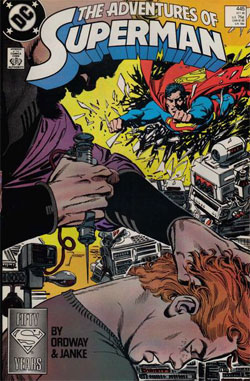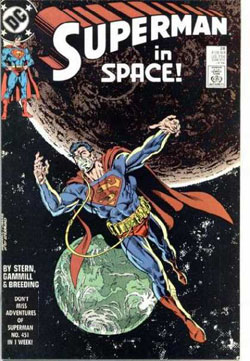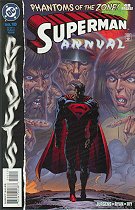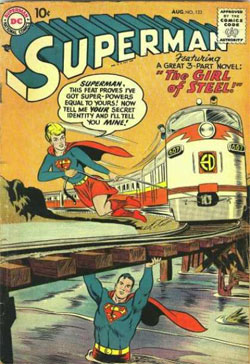Superman Comic Books
Superman: Special Reports
Superman - Judge, Jury, and Executioner - Part 2 (of 2)
Author: Sean Hogan (shogan@buckho.com)Last updated: February 11, 2002
Conscience and Consequences
 Even though Byrne departed after this story, the consequences of Superman's actions were examined by Adventures of Superman writer Jerry Ordway and the newly recruited Superman writer, Roger Stern.
Even though Byrne departed after this story, the consequences of Superman's actions were examined by Adventures of Superman writer Jerry Ordway and the newly recruited Superman writer, Roger Stern.
In Adventures of Superman #445, Superman broods in his boyhood bedroom. Pa Kent tries to find out what troubles his son so deeply, but Superman (significantly, Ordway has drawn him with his chest symbol in shadow - showing a dark hero, rather than a troubled, but human, Clark) is unable to confess, saying "I have to be alone ... to see if I can still live with myself ... with what I've done."
The rest of the issue is an encounter with Brainiac (his second appearance), whose psychic attack on Superman finds a darkness within. Brainiac senses a schism in Superman's subconscious and probes deeper until Superman finally snaps. With a face maddened with rage Superman's thoughts attack Brainiac"Your poking and prodding has stirred something held in check a long time, Brainiac ... my ANGER!! LOOK INTO THE FACE OF MY ANGER, VRIL DOX!!! I don't need to look into your mind, Brainiac, I can see the FEAR on YOUR face. The dawning realization of the KIND of control it takes to rein in a SUPERMAN'S BAD SIDE!!"
Some kind of psychic explosion destroys the building and renders Brainiac comatose. A withdrawn, emotionless Superman stirs only when a paramedic says, "You could've killed him!" His partner tells him to ease up, "Superman's no killer!" and the first one responds, "I meant he should've killed him." Superman only stares silently.
Superman suffers terrible delusions in Superman #25 when Brainiac, now under Luthor's control, tries further psychic attacks. Superman seems more like his old self in Adventures of Superman #448, although perhaps more indecisive and passive than usual. He tells a man admitting to murder that the courts are to decide his punishment and, "I'm not your judge, jury or executioner." This issue also marks the debut of a mysterious new and violent Gangbuster (the original Gangbuster, Jose Delgado, being sidelined with a broken back).
Superman grows increasingly haggard and lost over the next issues. Allowing facial stubble to grow, he looks like hell as both Superman and Clark. Finally, after some dramatic moments in Superman #27, we learn in Adventures of Superman #450 that the new, violent Gangbuster is really...
Superman. Who, until unmasked by the Guardian, is completely unaware that he has been having blackouts, during which he has being leading a secret life as Gangbuster. Horrified, Superman decides that he must leave Earth and his life as Clark Kent.
Exile And Redemption
 Quickly he arranges for Clark to disappear and says his farewell to his parents and to Lana. He confesses to his parents and they offer him excuses for his actions in killing the Phantom Zone criminals ("Surely it was in self defense?"; "Nothing's that cut and dried"; "You're a man, you're not perfect"). These excuses are rejected"I let my thirst for vengeance take control. I should have found an alternative to killing. I'm Superman."
Quickly he arranges for Clark to disappear and says his farewell to his parents and to Lana. He confesses to his parents and they offer him excuses for his actions in killing the Phantom Zone criminals ("Surely it was in self defense?"; "Nothing's that cut and dried"; "You're a man, you're not perfect"). These excuses are rejected"I let my thirst for vengeance take control. I should have found an alternative to killing. I'm Superman."
He then tells them of his blackouts and his actions as Gangbuster, "...I don't know what'll happen the next time I black out or even fall asleep! Who knows what monster will emerge? It could be Gangbuster or someone even worse!"
Saying his good-byes, he leaves Earth behind, possibly for good. The next several issues (Superman #28-31 and Adventures of Superman #451-454) have Superman trying to come to grips with his actions and his guilt, until he is captured by the dreaded Mongul, leader of Warworld. Superman's adventures on Warworld begin in the terrific Action Comics Annual #2 (1989) and continue in Superman #32, Adventures of Superman #455 and Superman #33 (these events are reprinted in the trade paperback collection, Superman: Exile).
It was during his time on Warworld that Superman met a long-lived being known as the Cleric. The Cleric had visited Krypton in its ancient past to preach to its people about the evils of cloning. To his horror, the Cleric inadvertently caused the death of his followers and, in penance and shame, exiled himself to a forlorn asteroid. In Superman #33 (written by Roger Stern), Superman and the Cleric seek atonement through a mechanical device which the Cleric had brought from Krypton -- the Eradicator.
The device linked the two men as they re-lived the scenes of their guilt. Superman watches as a Jury of Superman, glowing deathly green, pronounces the Phantom Zone criminals guilty, and as another glowing Superman Judge orders their deaths. He turns away as yet another Superman, in traditional uniform but with a green Executioner's mask, approaches the criminals and unseals the canister containing the green kryptonite. As he describes his dilemma to the Cleric, he approaches behind the Executioner and steps into him, becoming one, as the death sentence is carried out.
Superman says, "I buried them here, amid the desolation they'd created ... but I'll never bury my shame. It was the first time I had killed other living beings. I swear it will be the last!"
The Cleric tells Superman that, "your exile has deprived your world of a great hero, your family of a loving son. End your exile...". He continues, adding, "I have looked into your soul. Yours is the heart of a true hero ... if you have sinned, it was in the cause of justice."
Superman replies, "Cleric, I believe that life is a precious gift!" To this the Cleric responds, "Then do not seek to escape from it, as I did ... embrace it! Prove yourself worthy of being Superman by living and working for the preservation of life."
The strain of their psychic journey proves too much for the Cleric, who collapses. Dying he repeats, "Go forth, Superman ... fulfill your destiny! Do not ... fail me". Superman vows, "Be at peace, Cleric ... I won't fail you! As the stars are my witness ... I will champion life over death for the rest of my days!"
With those words, Superman ends his exile and returns home in a joyous Action Comics #643. The lessons he learned during his exile are not forgotten though, and continue to be a strong guiding force whenever Superman is faced with the choice of having to use deadly force.
Ghosts And Aliens
 The ghosts of the Phantom Zone criminals returned to haunt Superman in 1998's Superman Annual #10, written by Dan Jurgens. The story was part of the "Ghosts" annuals that had members of the JLA being haunted by phantoms, ending with JLA Annual #2.
The ghosts of the Phantom Zone criminals returned to haunt Superman in 1998's Superman Annual #10, written by Dan Jurgens. The story was part of the "Ghosts" annuals that had members of the JLA being haunted by phantoms, ending with JLA Annual #2.
The focus of the Superman story is on the moral issue of capital punishment (with the impending execution of a convicted killer) rather than on the morality of Superman's execution of the Kryptonian villains.
The capital punishment angle is dealt with in a heavy handed manner. Questions are raised, such as when Lois asks Clark if he is investigating the convict's story, "because you think he might be innocent ... or because you don't like capital punishment?" But neither the questions nor the different moral positions are effectively dealt with in the story and the resolution is contrived as the victim's family has a sudden change of heart, agreeing to spare the killer from his impending execution.
Superman doesn't even care whether the Kryptonians are ghosts or "plasma energy of some sort" as he uses energy from a lightning strike to disperse their essence. The issue could have been more effective in its use of the phantom villains had they tried a more subtle attack on Superman's conscience rather than a physical battle, or if Jurgens had Superman question his motives in executing them or in trying to prevent the scheduled execution of the convict.
Jurgens makes much more effective use of Superman's memories of his actions on the Pocket Universe and its effect on his moral code in the Superman vs Aliens miniseries. Early in the three issue prestige series (also in trade paperback), Superman reflects on his execution of the Phantom Zone criminals, "Killing those people was the worst thing I ever did. I was in agony. Tortured to the soul ... I had betrayed the core of my being. I'm no killer. It's a measure of desperation that I will never resort to again. No matter how deadly the threat."
In the series, a weakened Superman must battle the deadly and relentless creatures to save himself and young Kara of Argo City. Superman is pushed to the edge of his moral code as he defends himself, Kara and Lois from the Aliens. Though tempted, he refuses to kill -- with his powers as Superman he is convinced that there will always be another solution available to him.
The powerless supporting cast has fewer options and no qualms about killing the attacking Aliens. Superman doesn't stop those around him from killing the Aliens, and Jurgens nicely leaves open the question as to whether this is due to his weakened powers or because he agrees that the attackers must die, just not by his hand.
When an Alien larva, implanted in his chest, attempts to burst out, Superman vomits it into the void of space. Although not an intentional killing, Superman clearly values his life enough to prevent the Alien from emerging and "de-humanizes" (sorry, can't think of a better word) the Alien by calling it a "parasite" and a "creature".
Jurgens does a good job at showing the shades of morality while maintaining Superman's belief in his code against killing. As he confronts the final Alien, Superman says, "I look at you and all I can think of is an entire city of people who died! And, God help me, I can't help but wonder if you should join them."
"No. I went down that path once before. I won't do it again."
That resolve might yet be tested as the Superman writers have re-introduced a mysterious armoured and apparently super-powered character calling himself General Zod.
A Final Note: The Silver Age Superman Executioner
 A famous 1958 story, "The Girl of Steel" from Superman #123 (original series), bears a number of parallels to Byrne's story. In that story, Jimmy Olsen finds an ancient, magical Indian totem which grants him three wishes. His first wish is for "a Super-Girl, with super-powers equal to Superman's, would appear and become his companion." The story appears to be a warm-up to the 1959 introduction of Superman's cousin, Supergirl. However, Jimmy Olsen's third wish is to have Superman 'meet' his parents. To surprise Superman, Jimmy writes out his wish, but accidentally writes that he wants Superman to 'mate' his parents (wonder if anyone else shuddered at the possibilities?)
A famous 1958 story, "The Girl of Steel" from Superman #123 (original series), bears a number of parallels to Byrne's story. In that story, Jimmy Olsen finds an ancient, magical Indian totem which grants him three wishes. His first wish is for "a Super-Girl, with super-powers equal to Superman's, would appear and become his companion." The story appears to be a warm-up to the 1959 introduction of Superman's cousin, Supergirl. However, Jimmy Olsen's third wish is to have Superman 'meet' his parents. To surprise Superman, Jimmy writes out his wish, but accidentally writes that he wants Superman to 'mate' his parents (wonder if anyone else shuddered at the possibilities?)
Anyway, Superman gets whisked back in time to Krypton and his birth parents. Jor-el and Lara end up on one of Krypton's moons with a bad guy named Kil-lor (subtle, huh?). Kil-lor had invented a death ray to conquer Krypton. Being off-Krypton, everyone gets superpowers and Superman and Kil-lor battle to a standstill.
When Superman returns to his parents, he tells them that he is concerned that Kil-lor could still threaten Krypton by hurling missiles across space and adds that "If two radioactive rocks are banged together with super-force while heated to super-temperatures, it will create a nuclear explosion. But luckily that's Earth science that Kil-lor doesn't know."
Kil-lor, listening in with those sneaky super-powers, tries out the experiment and, smashing two pieces of radioactive minerals together, creates a Kryptonite filled crater around him.
Kil-lor cries out (his actual speech balloon says, "I'm going fast ... ahhhh ... (fade)") as the narrator adds that "Superman watches from a safe distance, as the dictator succumbs!"
What's really disturbing is Superman's thought balloon: "It's Kryptonite! Using my own telescopic vision, I spotted Kil-lor eavesdropping before! I tricked him into duplicating the very same chain reaction that blew up Krypton and created Kryptonite!"
Superman and his parents rejoice, Jor-el proposes to Lara, and Superman is whisked back to Earth.
No concerns are expressed at all about Superman tricking the villain into causing his own death. Superman makes no attempt to try and save him (at the very least by one of his patented super-long fishing poles). It appears that Superman's famed code against killing had some significant holes in 1958.
John Byrne could have been using this very tale as a template for his story where Superman executed the Phantom Zone criminals. Here, on a dead world, Superman kills a Kryptonian villain who has committed unspeakable crimes and who might cause further horrific crimes against an innocent planet. Returned to Krypton, the villain would have lost his super-powers, but would have tried to regain them and complete his threatened massacre.
Closing Thoughts
As controversial as Byrne's final story was, it led to some wonderful stories which seriously examined the decision made by Superman. The debate still remains: should DC have allowed a story where Superman deliberately killed? Was it a positive contribution to the Superman legend? Did it make a difference to you as a reader?
Another thought: Is Superman's moral code against killing now based, not on an inherent knowledge of right and wrong, but on his fear of the personal consequences?
Since we saw Superman go through a personal hell in this article, next time we'll see how he fares in a literal hell, as we review Superman's battles with the demonic siblings, Blaze and Satanus.
Relevant Links:
